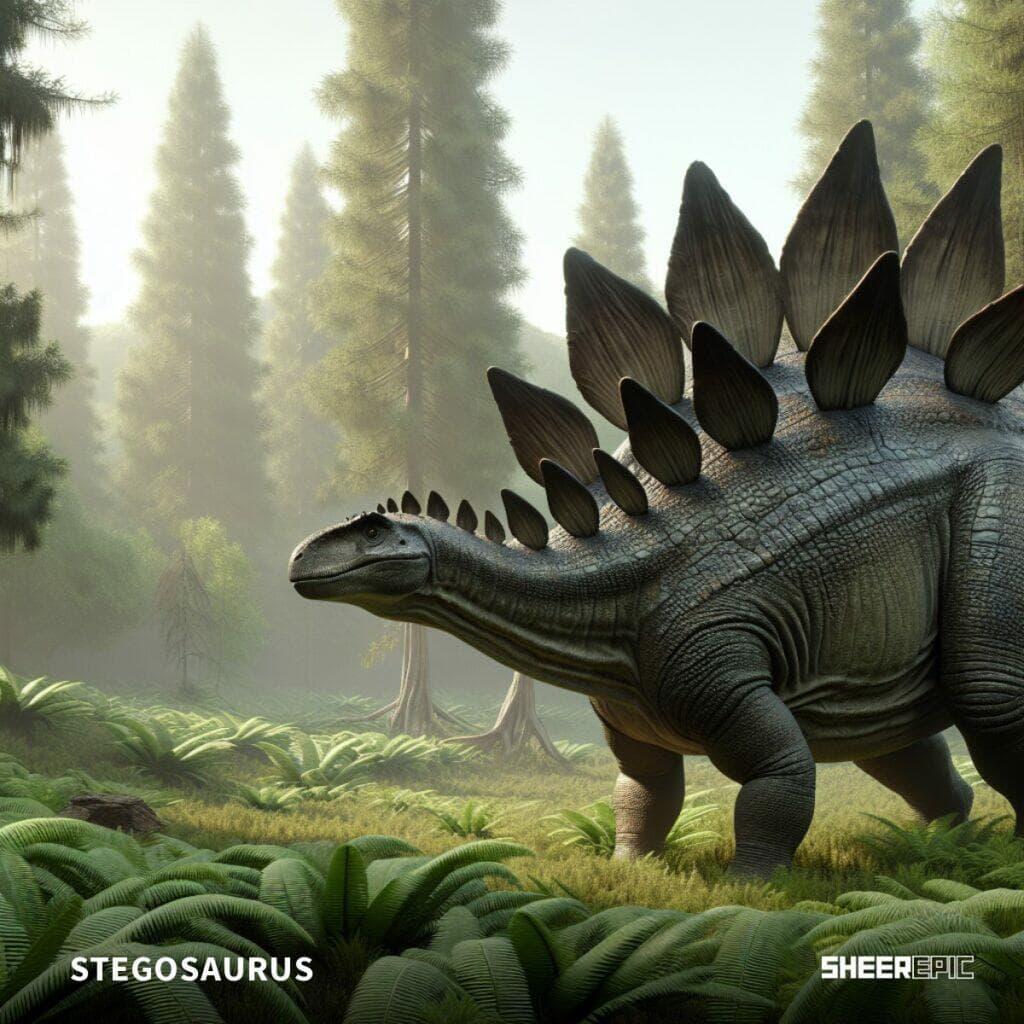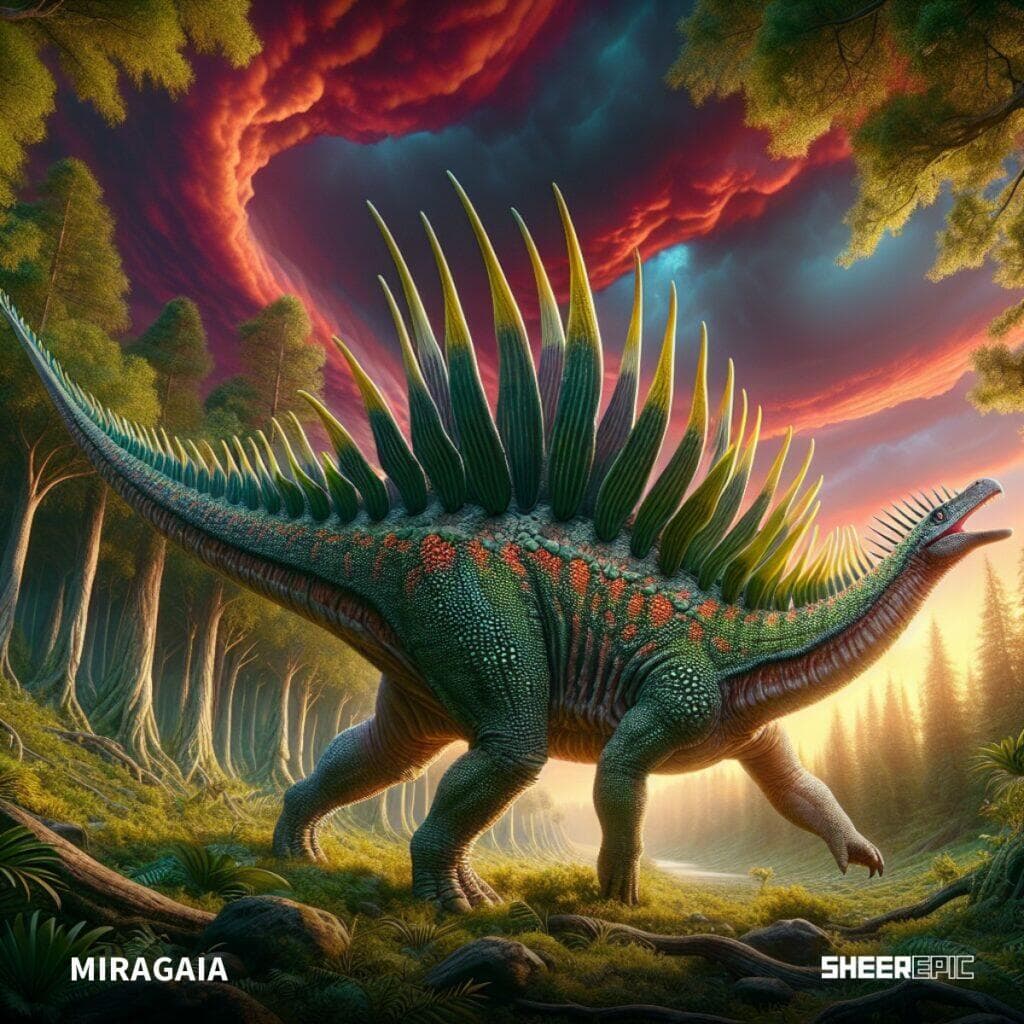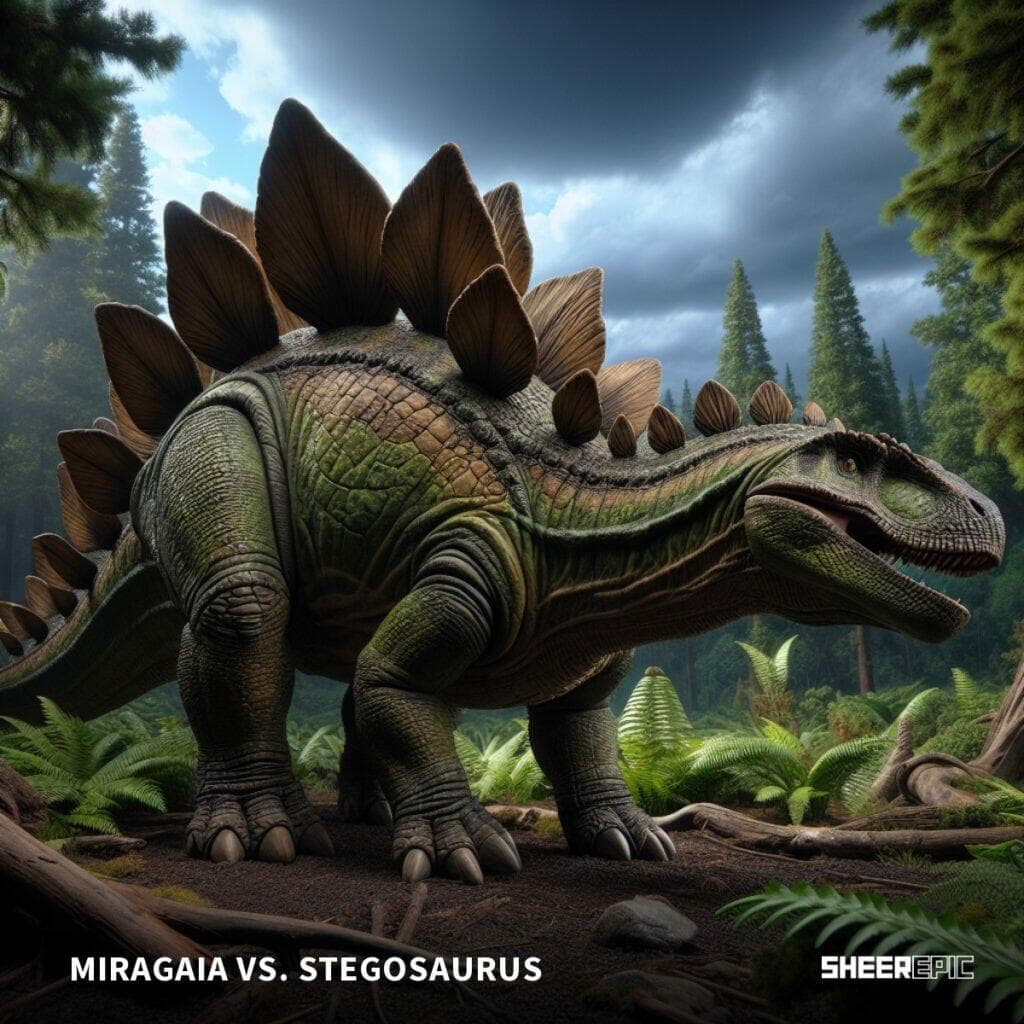The intriguing hypothetical battle between Miragaia and Stegosaurus has captured the imaginations of dinosaur enthusiasts everywhere. These two formidable herbivores, which both lived during the Late Jurassic period, possessed unique features that made them stand out among their fellow dinosaurs. Miragaia, with its longest neck known for any stegosaurian, and Stegosaurus, known for its iconic upright plates along their backs and spikes on their tails, would certainly have been a sight to behold.
When comparing these two giants, it’s essential to analyze several aspects, including their physical characteristics, defense mechanisms, and social behaviors. It’s important to recognize that while they coexisted during the same time period, Miragaia fossils have been found in Portugal, while Stegosaurus remains have been discovered in both Portugal and the western United States. As such, their geographic locations and ecosystems could have played a significant role in determining their survival traits and abilities.
Key Takeaways
- Miragaia and Stegosaurus both lived during the Late Jurassic period and possessed unique and distinctive features.
- Their geographical locations and ecosystems likely influenced their survival traits and abilities.
- Comparing physical characteristics, defense mechanisms, and social behaviors can offer insights into the hypothetical battle between these two fascinating herbivores.
Table of Contents
Comparison
Miragaia and Stegosaurus are both herbivorous stegosaurian dinosaurs that lived during the Late Jurassic period. They are members of the larger group Stegosauria, which includes other well-known dinosaurs such as Dacentrurus and Kentrosaurus. Although they share some common features, there are significant differences between these two dinosaurs that could affect the outcome of a hypothetical encounter.
Miragaia, also known as Miragaia longicollum, is notable for its extremely long neck, which consisted of at least 17 vertebrae. This feature is unique among stegosaurs and allowed Miragaia to reach higher vegetation than its counterparts. On the other hand, Stegosaurus is characterized by its iconic row of large, kite-shaped plates along the back and the long spikes on its tail called a thagomizer.
In terms of size, Stegosaurus is larger and generally heavier than Miragaia. Stegosaurus measures up to 9 meters in length and weighs approximately 5-7 tons. In contrast, Miragaia is smaller with a maximum length of 6 meters and an estimated weight of around 2 tons. The larger size of Stegosaurus could provide it with an advantage in terms of strength and defensive capabilities.
Both dinosaurs belong to the suborder Thyreophora, a group of armored ornithischian dinosaurs. The most distinctive feature of this group is the presence of bony plates and spines covering their bodies, which provided them with added protection against predators, such as Allosaurus.

The tail spikes of Stegosaurus, known as the thagomizer, were its primary weapon for defense and possibly offense. These spikes could reach lengths of up to 1 meter and were capable of inflicting serious damage to any potential threat. Miragaia also had tail spikes, but they were generally shorter and less developed compared to those of Stegosaurus.

The long neck of Miragaia, its most distinguishing feature, could be both an advantage and a vulnerability. While it allowed the dinosaur to reach higher vegetation, it also exposed a larger surface area that could potentially be targeted by predators or opponents. On the other hand, the prominent plates on Stegosaurus’ back may have provided additional protection to its neck and vital organs.
Comparison Table
Miragaia and Stegosaurus were both herbivorous dinosaurs that belonged to the stegosaurian family. However, they had distinct features and characteristics that set them apart from each other.
Here is a comparison of the two dinosaurs:
| Feature | Miragaia | Stegosaurus |
|---|---|---|
| Neck length | It had the longest neck of any stegosaurian, with at least 17 vertebrae | Shorter neck with fewer vertebrae |
| Spikes | Predominantly smaller spikes along its back and tail | Four long spikes on the tail, used for defense |
| Plates | Smaller, more numerous plates | Larger, more distinct plates |
| Size | Smaller in size compared to Stegosaurus | Larger and more robust |
| Geographical distribution | Primarily found in Portugal and possibly Wyoming, United States | Widespread across North America and Europe |
| Time period | Late Jurassic period | Late Jurassic to early Cretaceous period |
In terms of physical strength, Stegosaurus was likely more robust than Miragaia. Its larger size, long tail spikes, and stronger build could have given it an advantage in a hypothetical encounter. However, its shorter neck could have limited its ability to grasp vegetation during feeding.
Miragaia, on the other hand, had a more slender build and a long neck, which allowed it to reach vegetation that would have been inaccessible to Stegosaurus. While its smaller size and less prominent weaponry might have made it less fearsome in terms of raw power, its longer neck could have provided it with an advantage in reaching food sources.
When comparing these two dinosaurs, It is essential to consider their different adaptations and ecological niches, which might have minimized direct competition for resources. In their respective habitats, both species would have been well-suited to their environment and unique feeding patterns, playing a significant role in maintaining the balance of their ecosystems.
Physical Characteristics
Miragaia, a long-necked stegosaurid dinosaur, is known for its unique anatomy. It possesses the longest neck among stegosaurians, consisting of at least 17 vertebrae. The cervical vertebrae in Miragaia are elongated, making its neck significantly longer than other stegosaurs. Its skeleton also includes noticeable rib features, an ilium, and dorsal vertebrae.
On the other hand, Stegosaurus is a well-known herbivorous dinosaur characterized by its distinctive kite-shaped, upright plates along its back and spikes on its tail, known as a thagomizer. The arrangement of its bony plates and neural spines gives Stegosaurus a unique appearance.
Both Miragaia and Stegosaurus have dermal spines, although these structures differ in size and shape between the two dinosaurs. Miragaia has long, slender dermal spines while Stegosaurus has shorter and wider bony plates.
In terms of limbs, Miragaia’s forelimbs are slightly longer than the average stegosaurian, with elongated metacarpal bones and phalanges. Stegosaurus, on the contrary, has relatively short forelimbs when compared to its hindlimbs.
The femur is another bone to compare between these two dinosaurs. The femur in Miragaia is fairly similar in length to that of Stegosaurus. However, Miragaia’s femur is more slender and shows differences in the structure of its neural arches.
Focusing on the head and teeth, the skull of Miragaia is not well-known, but it is assumed to be similar in shape to other stegosaurians. In contrast, Stegosaurus has a small, elongated skull equipped with small, peg-like teeth. These teeth are not suited for heavy-duty chewing, suggesting a diet of soft vegetation.
The above physical characteristics provide insight into these two fascinating species of stegosaurians and help to evaluate their potential strengths and weaknesses.
Diet and Hunting
Both Miragaia and Stegosaurus were herbivorous dinosaurs, which means they primarily fed on plants. As quadrupedal dinosaurs, they had a relatively low body posture, allowing them to easily reach and graze on low-lying vegetation, such as ferns, horsetails, and small shrubs.
Miragaia, with its long neck, had a unique advantage when it came to browsing for food. The long neck provided an extended reach, which enabled it to access vegetation that was higher off the ground than other herbivores. This feeding strategy could have reduced competition for resources and given Miragaia an edge in its environment.
In contrast, Stegosaurus had a shorter neck, which limited its ability to browse for taller vegetation. However, it was also equipped with a strong beak and specialized teeth, which allowed it to consume a wide variety of plant materials. We can assume that both of these dinosaurs shared similar ecosystems, given their overlapping temporal range, even though their fossils have been found in different geographical locations.
Neither Miragaia nor Stegosaurus were hunting animals, as they were not equipped with the tools needed to catch and kill prey. Unlike theropods, which were carnivorous and active predators, herbivorous dinosaurs like Miragaia and Stegosaurus relied solely on plant matter for sustenance. However, they still had to be wary of predators, like theropods or other carnivorous dinosaurs, which might have hunted them for food.
These herbivorous dinosaurs coexisted with various animals during their time, including small mammals and other reptiles. It is possible that some smaller animals may have lived in symbiosis with these large herbivores, helping to keep their environment clean of parasites or harmful insects, while benefiting from the protection provided by the massive dinosaurs.
The diet and feeding habits of herbivorous dinosaurs like Miragaia and Stegosaurus greatly influenced their overall behavior, physiology, and adaptations. As plant-eaters, they would have spent much of their time searching for and consuming food, ensuring that they acquired enough nutrients to maintain their large body sizes and support their needs for growth, reproduction, and defense against predators.
Defense Mechanisms
Miragaia and Stegosaurus, both herbivorous stegosaur dinosaurs, possessed various defense mechanisms to protect themselves from predators. The primary defense structures in both species included spikes and bony plates, which served different purposes.
Miragaia was a smaller and more lightweight stegosaur, measuring around 6-6.5 meters in length and weighing around 2 metric tons. Its most notable feature was the presence of elongated neck vertebrae, which allowed for improved mobility and reach while foraging. However, its primary defense mechanism consisted of sharp, bony spikes known as dermal spines. These spikes protruded from its tail and were capable of inflicting significant damage to potential attackers.

On the other hand, Stegosaurus was a more robust dinosaur with a body length of up to 9 meters and a weight of 5 metric tons. This four-legged herbivore was characterized by large, kite-shaped bony plates along its back, earning it the nickname “roof-lizard.” The purpose of these plates remains uncertain, with some theories suggesting they might serve as defensive structures or play a role in thermoregulation.
Additionally, Stegosaurus had a specialized weapon at the end of its tail called the thagomizer. This structure is composed of four long and sharp spikes, which could be swung at predators with significant force. The thagomizer was an effective deterrent and could cause considerable injury to any attacker.
Intelligence and Social Behavior
Miragaia and Stegosaurus were both herbivorous dinosaurs that lived during the Late Jurassic period. However, they had different characteristics that might have influenced their intelligence and social behavior.
Miragaia was a long-necked stegosaurid dinosaur with the longest neck known for any stegosaurian, allowing it to reach higher vegetation. Stegosaurus was characterized by its distinct kite-shaped upright plates along its back and spikes on its tail. These physical adaptations were primarily for defense against predators and for thermoregulation.
When it comes to intelligence and social behavior, little is known about these stegosaurians. There is no concrete evidence pointing towards their social structure or level of intelligence. However, anecdotal observations and comparisons to other herbivorous dinosaurs suggest that they may have had some level of social interactions. For instance, some fossil finds reveal that these dinosaurs lived in the same habitat and might have coexisted.
Paleontologist Susannah Maidment is a leading expert on stegosaurians. She suggests that these dinosaurs might have had simple social structures, similar to those found in other herbivorous dinosaurs. Although there might have been some level of social interaction among members of the same species, it is uncertain if they had complex communication or exhibited advanced problem-solving abilities.
Key Factors
Miragaia and Stegosaurus were both herbivorous dinosaurs that lived during the Late Jurassic period, around 150 million years ago. Both dinosaurs had distinct features, which can be compared to determine the winner in a hypothetical battle.
Miragaia, found in the Upper Jurassic rocks in Portugal, was a long-necked stegosaurid with an elongated neck consisting of at least 17 vertebrae. This unique feature allowed Miragaia to reach vegetation at higher levels, which could have been advantageous when competing for resources with other herbivores. Its body mass and fusion of certain skeletal structures suggest a robust build. Miragaia might have evolved an elongated neck through sexual selection or other evolutionary pressures.
In contrast, Stegosaurus had a shorter neck, but was characterized by the distinctive kite-shaped upright plates along their backs and spikes on their tails. These features provided Stegosaurus with added protection against predators. Stegosaurus fossils have been found in both the western United States and Portugal.
When comparing the two dinosaurs, several factors should be considered, such as their body mass, presence of juvenile individuals, and the role of sexual selection. Juvenile dinosaurs were likely more vulnerable in confrontations due to their smaller size and less-developed defensive structures. Furthermore, sexual selection could have played a role in the development of certain features such as elongation in Miragaia’s neck.
Mamenchisaurus, Euhelopus, Omeisaurus, and Dinheirosaurus are sauropods that existed in the same era as Miragaia and Stegosaurus. These dinosaurs had elongated necks, similar to Miragaia, but were much larger in size. The dorsal centra in these sauropods, especially Euhelopus, were also elongated, allowing them to reach even higher vegetation. Comparing these dinosaurs to Miragaia and Stegosaurus provides a broader context for understanding their morphology and survival strategies.
Who Would Win?
In a hypothetical battle between a Miragaia longicollum and a Stegosaurus, various factors need to be considered, such as their respective body structures, adaptability, and environments.
Miragaia is known for its long neck, making it unique among stegosaurs. With at least seventeen vertebrae, it had the longest neck known for any stegosaurian. On the other hand, Stegosaurus is characterized by its distinctive upright plates along its back and tail spikes. These plates and spikes may have served as an effective defensive mechanism.
The construction of their limbs is also crucial. Miragaia’s long neck could have helped it reach higher vegetation, whereas Stegosaurus had a broader body and shorter limbs. In terms of their metacarpals and phalanges, both dinosaurs benefitted from a relatively stable, if not overly agile, arrangement of bones that would have allowed them to navigate their respective environments efficiently.
In terms of systematic paleontology, Miragaia longicollum shares similarities with Alcovasaurus, which was also known as Miragaia longispinus, and Dacentrurus armatus. All of these species belong to the stegosaurian group but have differing autapomorphies or unique features.
While the length of the Miragaia’s femur is unknown, in comparison, the Stegosaurus had a stout femur allowing it to support its massive body. Considering the size and weight of these dinosaurs, their femurs played a vital role in their mobility.
Miragaia remains have been found mostly in the Upper Jurassic rocks in Portugal, whereas Stegosaurus fossils have been found in the western United States and Portugal from the Late Jurassic period. The Morrison Formation in Wyoming, United States, indicates that Alcovasaurus, a variant of Miragaia, may have shared the same habitat as Stegosaurus.
Taking these factors into account, it remains uncertain who would win in a contest between Miragaia and Stegosaurus. Their unique physical characteristics and adaptations would certainly play a significant role in determining the outcome of a confrontation.
Frequently Asked Questions
How do Miragaia and Stegosaurus compare in size?
Miragaia was a smaller stegosaur compared to Stegosaurus. Miragaia longicollum had a particularly long neck, which consisted of at least 17 vertebrae. On the other hand, Stegosaurus was a larger dinosaur with distinctive upright plates along its back and spikes on its tail.
What are the key differences between Miragaia and Stegosaurus?
The most notable difference between Miragaia and Stegosaurus is the length of their necks. Miragaia had an unusually long neck, which made it unique among stegosaurs. In contrast, Stegosaurus had a relatively short neck. Additionally, the armored plates and tail spikes of Stegosaurus were more prominent and distinctive than those of Miragaia.
What are the primary weapons of Miragaia and Stegosaurus?
The primary weapons of both Miragaia and Stegosaurus were their spikes and armored plates. Miragaia’s long neck could have potentially been used for defense or to deter predators. On the other hand, Stegosaurus had large, sharp spikes on its tail known as thagomizers, which could be used to strike predators or other animals in battle.
How do the defensive capabilities of Miragaia and Stegosaurus differ?
While both stegosaurs possessed defensive spikes and armor, Stegosaurus had a more robust defensive arsenal, with its large, sharp tail spikes and distinctive upright plates. Miragaia’s longer neck may have helped it access food sources that were normally out of reach for stegosaurs, but it is unclear if this would provide a significant advantage in defense.
What were the habitats of Miragaia and Stegosaurus?
Stegosaurus primarily inhabited the western United States and Portugal during the Late Jurassic period. Fossils of Stegosaurus have been discovered in Kimmeridgian to Tithonian-aged strata. Miragaia, meanwhile, has mainly been found in Upper Jurassic rocks in Portugal (Lourinhã Formation, Sobral Unit) and possibly also in Wyoming, United States (Morrison Formation). These habitats were likely characterized by forests, swamps, and riverine environments.
How does their speed and agility compare in a battle?
Neither Miragaia nor Stegosaurus were particularly known for their speed or agility. As herbivorous dinosaurs, their primary focus was on feeding and evading predators rather than engaging in active combat. However, Stegosaurus’s larger size and more prominent defensive structures may have given it a slight edge in battle when compared to Miragaia, despite its smaller size and long neck.


